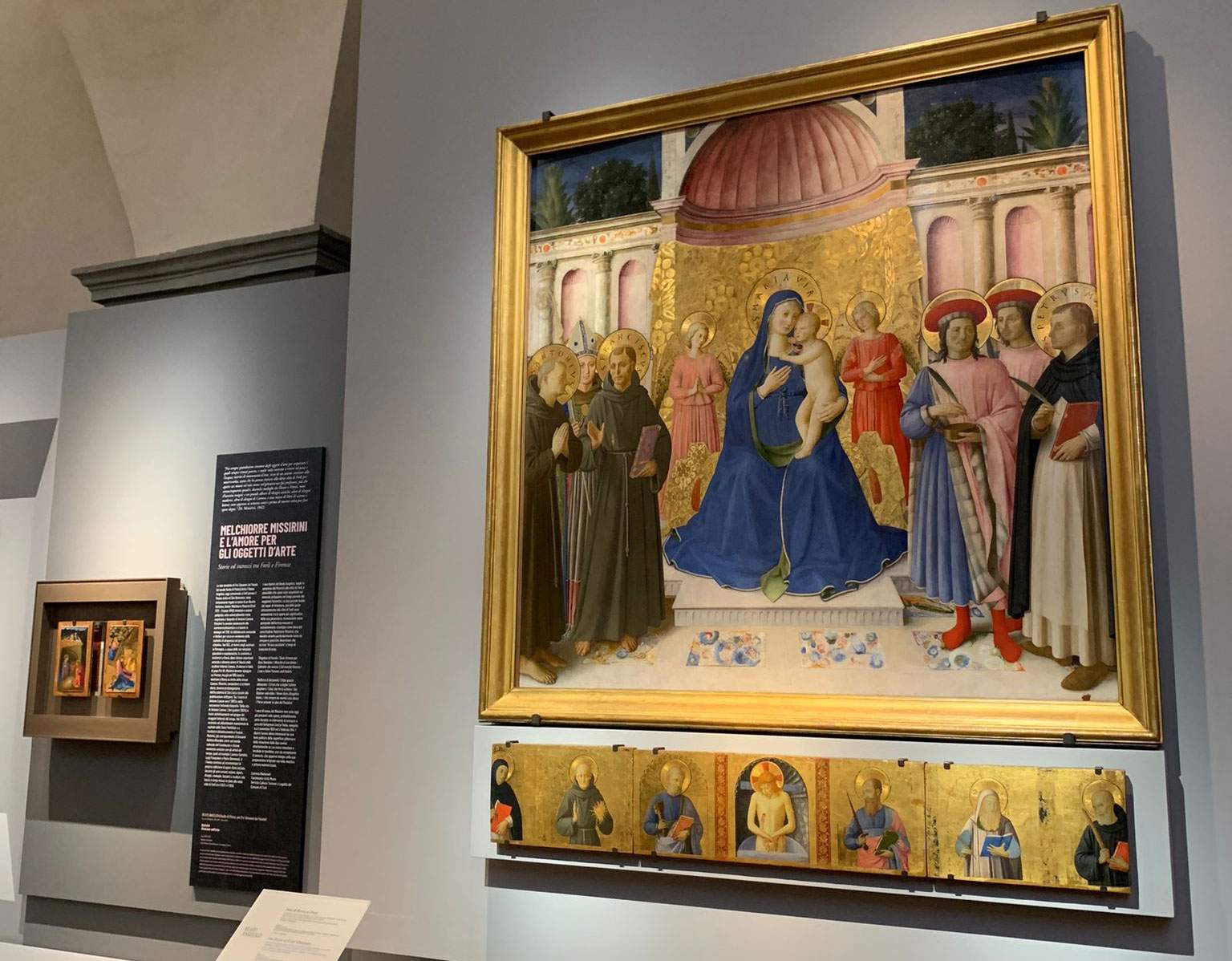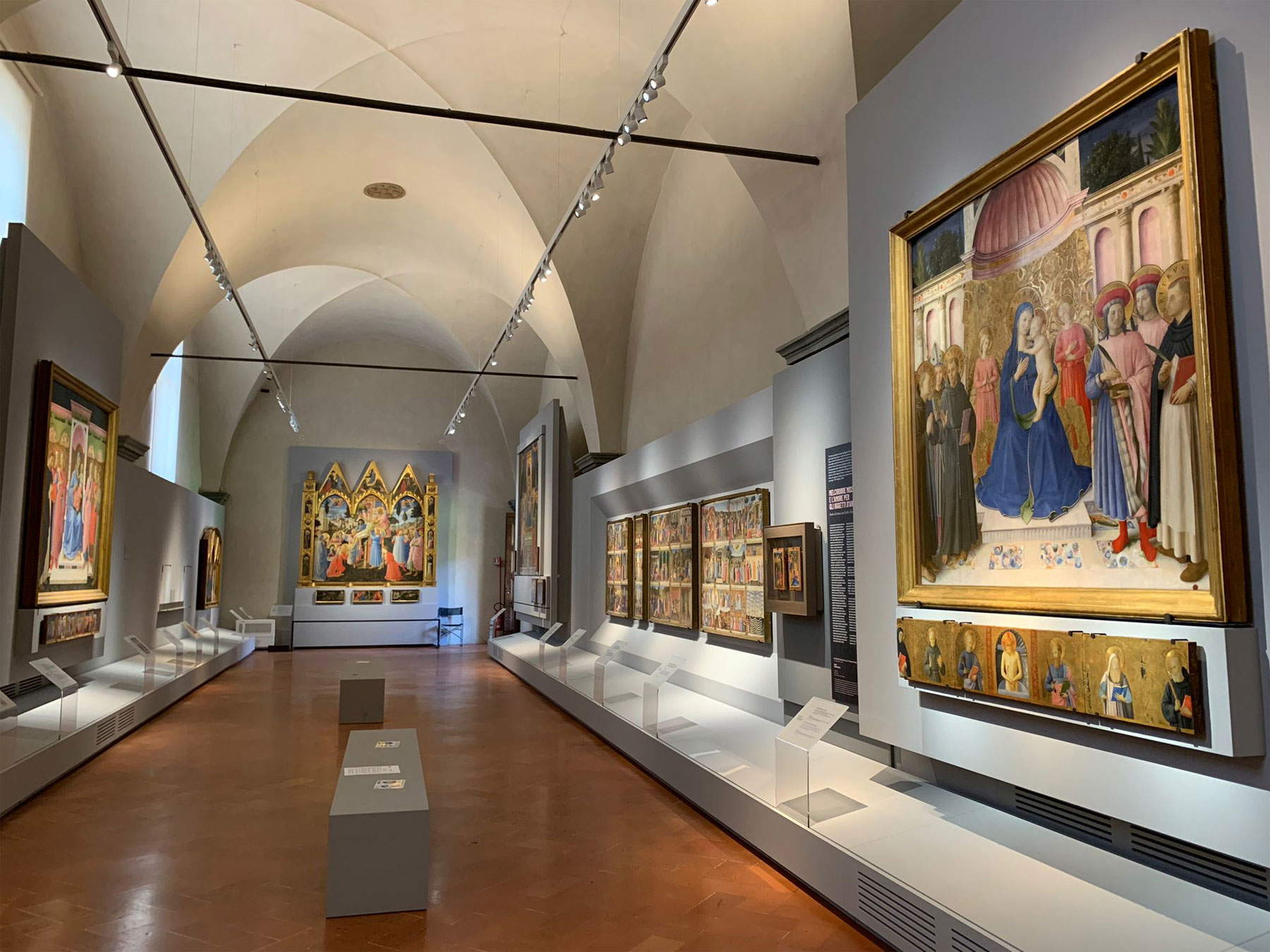After restoration work, the Bosco ai Frati Altarpiece, a masterpiece by Beato Angelico (Giovanni da Fiesole, born Guido di Pietro; Vicchio, c. 1395 - Rome, 1455), restored by Lucia Biondi thanks to the contribution of the Friends of Florence, returns to the San Marco Museum in Florence. The work’s return to the Hall of Beato Angelico adds a key work to the monographic exhibition of the Dominican painter and friar’s extraordinary masterpieces, which brings together the monumental panels, smaller paintings, exquisite predellas and reliquaries.
The Bosco ai Frati Altarpiece is the last, great undertaking on panel by the great Dominican artist, probably executed in the years 1450-52, in conjunction with the fascinating panels of the Armadio degli Argenti for the church of Santissima Annunziata in Florence, when the artist held the post of Prior of the Convent of San Domenico in Fiesole, before leaving for Rome where he would die in 1455. Almost at the end of his human and artistic experience, Beato Angelico renewed with this prestigious commission, almost certainly entrusted to him by Cosimo the Elder, his deep connection with the Medici and their favorite architect, Michelozzo di Bartolomeo. The altarpiece was in fact executed for the church of the Franciscan convent of Bosco ai Frati in Mugello, of which the Medici were patrons and which was designed by Michelozzo.
The composition of the altarpiece is dominated by the central figure of the Virgin flanked by two angels, seated not on a throne but on a singular seat completely concealed by a sumptuous gilded drape, with a sumptuous cushion of distant Byzantine memory, also gilded. Our Lady’s mantle expands at her feet until it occupies almost the entire marble step and, moreover, for the width of the wide niche in the background, which is also concealed by another large gilded drape. In the left foreground are painted figures of Saints Francis, Louis of Toulouse, and Anthony of Padua, characterized by a strong naturalistic accent. On the right are the medical saints Cosmas and Damian and St. Peter the Martyr, patrons of the Medici family. The work as a whole is an admirable synthesis between the sumptuousness of a courtly work and Franciscan simplicity, supported by the unparalleled preciousness of Angelic pictorial draftsmanship.
 |
| Bosco’s Altarpiece to the Friars restored |
“The Bosco ai Frati Altarpiece,” explains Angelo Tartuferi, director of the San Marco Museum, “is certainly to be counted in the nucleus of the great masterpieces within the copious production of the friar painter that has come down to our own day. Almost at the end of his human and artistic experience, Beato Angelico renewed with this prestigious commission his deep bond with the Medici and their favorite architect, Michelozzo di Bartolomeo. The latter had in fact been commissioned in 1438 by Cosimo the Elder to renovate the ancient convent of San Bonaventura al Bosco ai Frati where the Observant Franciscans had established the seat of their congregation, not far from the Medici villas of Trebbio and, above all, Cafaggiolo. Thus the work was commissioned from the painter almost certainly by Cosimo the Elder, who might perhaps have been succeeded by his son Piero de’ Medici, in light of the seemingly incongruous presence of the Dominican Saint Peter the Martyr, eponymous precisely with Cosimo’s son. As has been noted by critics, the altarpiece expresses the lofty and solemn, one might say ’timeless’, language that characterizes the frescoes with the Stories of Saints Stephen and Lawrence of the Niccolina Chapel in the Vatican painted in 1447-1448, with which it shares in particular the prominence assigned to the architecture, rightly defined as ’pre-Bramantesque’ in the light of its close dependence on Roman exemplars. Equally evident appears the fascination with the Ancient, savored by the artist in his first stay in Rome, evoked by the grandiose niche within which the Virgin sits, in which a direct reference to the Pantheon has been identified. However, along with the accents just described, the painting offers in some passages authentic peaks of ’Flemish-style’ naturalism, such as the physiognomies and robes of the saints, or the details of the architecture in the background. The work as a whole is an admirable synthesis of Medici opulence and Franciscan simplicity, sustained by the unparalleled preciousness of Angelic pictorial draftsmanship.”
“Both the altarpiece and the predella,” Tartuferi adds, “underwent a noticeable curtailment, of about 12 centimeters per side, to be adapted to the space of the large Baroque complex built in 1626 for the high altar of the church of the Bosco ai Frati convent. As in so many other cases, this masterpiece has not escaped the reckless aggressive cleaning of the past, which significantly compromised some parts, for example the physiognomies of Saints Anthony of Padua and Peter the Martyr at the side ends of the panel, or the architecture and landscape background beyond the latter. The skillful, thoughtful restoration by Lucia Biondi, made possible by funding from the Friends of Florence, gives the work a new legibility, the salient feature of which is the perception of an absolute homogeneity between the different parts and, above all, in such a way that the intervention is really noticeable in a very small way. Authentic test case, the latter, of any truly successful restoration. The altarpiece is finally reunited with its predella, already restored a few years ago, and will be able to be admired in the renovated Beato Angelico room, from which only the Franciscan Triptych, executed for a religious company attached to the church of Santa Croce in Florence, currently being restored at the Laboratories of the Opificio delle Pietre Dure at the Fortezza da Basso, is now missing.”
As in so many other cases, this masterpiece did not escape the reckless aggressive cleaning of the past, which significantly compromised certain parts, for example the physiognomies of Saints Anthony of Padua and Peter the Martyr at the side ends of the panel, or the architecture and landscape background. With the restoration, which lasted a year and was carried out by Lucia Biondi, the painting regained its pictorial values, extreme transparency and luminosity. Apart from the dark notes of the “night” sky at the top and the tonalities of the saints on the left, the colors are everywhere light, spread out in thin layers, so that the light penetrates down to the basic preparation, and in many cases the preparatory drawing is visible. The palette is tuned to cool tones. The warm, enveloping note is represented essentially by the Virgin’s canopy, all in pure gold engraved with astonishing skill. The blue backgrounds are totally based on lapis lazuli, in its most precious variety, from Afghanistan. The extensive use of pure gold and lapis lazuli, a very expensive pigment, confirm an important patronage such as that of Cosimo de’ Medici.
 |
| The Bosco ai frati altarpiece in the Beato Angelico room at the Museo di San Marco |
“The restoration of the Bosco ai Frati Altarpiece, which lasted for a year from May 2020 to May 2021 and was financed by the Friends of Florence association,” explains Lucia Biondi, “has made it possible to achieve the objectives we had set for ourselves in the planning and preliminary stages. As we have already had occasion to say, the vision of the painting appeared conspicuously penalized by dirt and alteration of the varnish and old retouches, dating back to the last restoration in 1955. Although this problem is very frequent on ancient paintings, it assumed an even more negative weight in our case. We are in fact dealing with one of Beato Angelico’s masterpieces in his mature phase, when his technique, still based on pigments mixed with egg tempera, nevertheless takes on an extreme lightness and transparency, which in the altarpiece appeared muffled by a gray, opaque layer. It therefore became apparent immediately that the focus of our intervention would be cleaning, a particularly delicate operation on such kind of backgrounds. For this reason, the work was preceded by a comprehensive campaign of diagnostic investigations, aimed at fine-tuning both the right method of intervention and knowledge of the technique and materials used by the artist. In this regard, the experience gained in 2019, when we restored another emblematic work by Beato Angelico, in this case from his early period, namely the Last Judgment, also from the Museo di San Marco and also last restored in 1955, was of great help.”
“We have thus had the privilege of deepening our knowledge of the technique employed by the artist, which greatly evolved over the course of his production, but was always characterized by a very high standard of quality,” the restorer adds. “During our work, we have put together a series of unpublished discoveries, a cultural adventure of immense fascination for those in our profession, which will be shared with scholars in the course of two publications planned soon. Another crucial moment of the restoration was the retouching of the color abrasions caused by ancient cleaning, which on a rarefied material such as the one we have described had serious consequences. To intervene at the tip of the brush, with great lightness and absolute respect, we were guided this time by the careful study of the other works by Angelico preserved in the Museum of San Marco, an island of peace that has often welcomed us in this year of seclusion and pandemic. We hope there is a shared consensus in affirming that this work, a symbol of Florentine Humanism and Renaissance, can once again be fully included in the current of ’light painting.’ A definition coined by critics to describe a brief (1439-1460) but important moment in mid-15th-century Italian art, linked above all to Florence and Tuscany.”
“The altarpiece, juxtaposed with its predella already restored a few years ago, can now be admired thanks to the ever constant support of the Friends of Florence in the renovated Beato Angelico room,” says Stefano Casciu, regional director museums of Tuscany. “The magnificent restoration has restored the most subtle values of this sumptuous yet essential panel, which once again demonstrates the subterranean links between Beato Angelico’s art and the contemporary experiences of Flemish painting.”
“Some of our Friends of Florence are true fans of Beato Angelico,” stresses Simonetta Brandolini d’Adda, President of Friends of Florence, “and they recognize his marvelous mastery and intense spirituality as a trait so evident in all his works. Lucia Biondi’s excellent restoration has highlighted ever more the importance of this altarpiece by enhancing its colors, faces and sublime architecture. We are pleased to also add this work to the renovated Sala Beato Angelico now finally reopened to the public.”
 |
| Restoration of the Bosco ai frati altarpiece, a masterpiece by Beato Angelico, ends |
Warning: the translation into English of the original Italian article was created using automatic tools. We undertake to review all articles, but we do not guarantee the total absence of inaccuracies in the translation due to the program. You can find the original by clicking on the ITA button. If you find any mistake,please contact us.